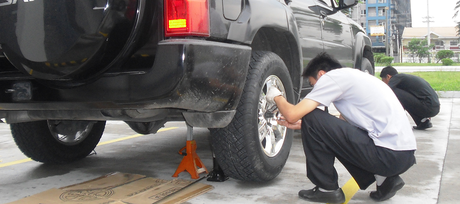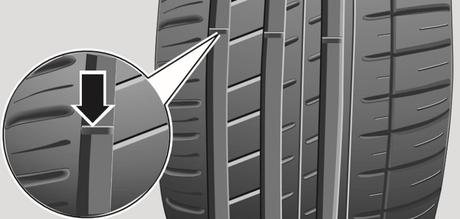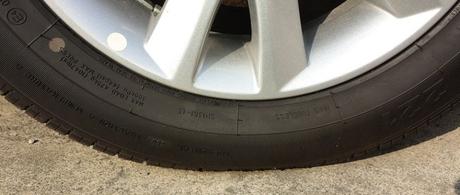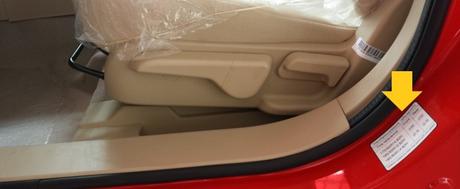
How Often to Rotate Tires
Defective tires are very dangerous! If tires are damaged, excessively worn, or have improper pressure, do NOT continue the driving. While driving, pay close attention to the state of tires and regularly check for deformations (bulging) in the treads and tire sides. Also check for scratches, abnormal wear, cracks, nails, etc. The most common causes of tire ineffectiveness are impacting or friction with curbs, driving over deep pits on the road, tire pressure being too low or too high.
How Often to Rotate Tires
Tires should be rotated for every 8,000 to 13,000 km driven. Whenever abnormal wear is found, you should rotate the tires as soon as possible and check the wheel alignment. It is also necessary to check to see whether the tires or wheels are damaged.

When to Replace Tires?
There are wear marks on the original tires. These marks are at the bottom of the tread patterns and distributed around the tire. When the treads are worn to the wear marks, continuous rubber imprints will be left on the ground when emergency braking. These imprints will run through the whole width of the tires.

How to Check Tire Tread
Tire Air Pressure
The correct tire air pressure can prolong the service life of tires. It can also ensure the best combination of driving comfort, fuel economy and drivability. When the tire pressure is too low, it will intensify tire wear, greatly affect the drivability and fuel economy of the vehicle and increase the danger of lost tire effectiveness. If the tire pressure is too high, it will cause driving instability and uneven tire wear, thus reducing the service life of the tires. Check tire pressure (including spare tires) at a frequency of at least once a week.
Tires must be checked when they are in a state of normal temperature - as long as the vehicle has been driven for 1.6 km, it is enough to make tires fully heat up, thus affecting tire pressure. The pressure of hot tires is bound to increase. If tire pressure has to be checked when the tires are hot (after the vehicle has been driven for a period of time), the pressure should have risen approximately by 0.2~0.5bar. In such a situation, please do NOT deflate the tires for the purpose of making the tire pressure up to the standard.
When to Check Tire Pressure?
Tires should be checked at least once a week. Do NOT forget to check compact spare tires. Their pressure should be 4.2bar.
How to Check Tire Air Pressure?;
A high-quality mini tire pressure gauge may be used to check tire pressure. It is not possible to determine whether the tire pressure is normal by visual checks alone. Even if not adequately inflated, radial tires still look very normal.
Check inflated tire pressure when they are cold. “Cold Tires” means tires that have not been driven for more than three hours or have been driven not over 1.6 km. Remove the valve cap from the valve core of the tire, press the tire pressure gauge to the valve with force, and then the tire pressure will be displayed.
No adjustment will be needed if the inflated pressure of the cold tire meets the recommended pressure valve on the tire and loading information label. If the pressure is too low, it is needed to inflate until the pressure value reaches the recommended value. If the pressure is too high, the valve core may be pressed to deflate until the pressure value reaches the recommended value. After the check is completed, be absolutely sure to screw the tire valve caps back on the valve core. The tire valve caps can prevent dust and moisture from entering the tire.

Tire Pressure Monitoring
This system consists of four pressure sensors and one tire pressure receiver. The sensors are mounted inside the four hubs. The sensors wirelessly transmit the pressure, temperature and sensor battery voltage signals collected real-time. The receiver sends them for display on the multi-functional display screen of the trip computer on the instrument cluster
Tire Puncturing
If your vehicle is equipped with tubeless tires. When the tires are punctured by a sharp object, there may not be apparent air leakage in the tires. If you are in such a situation, immediately slow down and drive carefully. Replace the punctured tire with a spare tire or repair it. This type of puncturing will reduce tire air pressure. It is therefore very important to regularly check tire air pressure. Punctured or damaged tires must be immediately repaired or replaced as soon as possible.
Storage Instructions for Tires
Before removing tires, be sure to mark them indicating their turning direction. When mounting the tires, follow the marks to reposition them. This can ensure that the turning direction and dynamic balancing state of the wheels will be kept unchanged. The removed wheels and tires should be stored in a cool and dry place, ideally in shade, away from sunlight. Tires which are not yet mounted on the vehicle should be stored vertically.
Hidden Damage
Damage to the tires and rims is often difficult to spot. While the vehicle is running, if the vehicle vibrates abnormally or deviates, it is likely that one tire has a fault. In such a situation, you should go to any tire shop to have the tire checked as soon as possible and change the tire if necessary.
In the initial 500 km, it is unlikely that new tires will reach a state of their best road adhesion. Therefore, you should carefully drive the vehicle at a medium speed so as to prevent accidents.
Tires that have not undergone a wear-in period or tires that have been over-worn will have insufficient road adhesion. This will directly affect the braking effect. If the tires are damaged, do NOT continue driving, because damaged tires may get punctured while driving, thus resulting in traffic accidents and personal injuries.
The tire pressure must meet the provisions. Otherwise, it may cause accidents. If the vehicle is still driven at a high speed when tire pressure is insufficient, it will make the tires bend, thus extremely easy to cause tire overheating and worst tire bursting may occur. Follow the car manufacturer recommended tire pressure.

Valve Hole
Keep the tire valve caps tightly screwed downwards to prevent dust from entering the valve hole. While checking tire pressure, check whether the valve hole leaks (ideally use a soap liquid to see if air bubbles emerge).
